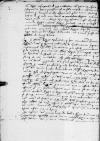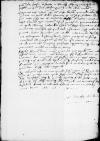List #476
Ioannes DANTISCUS do Bernhard von HÖFEN (FLACHSBINDER)Bologna, 1530-03-17
Rękopiśmienne podstawy źródłowe:
Pomocnicze podstawy źródłowe:
Publikacje:
| ||||||||||||||||||||
Tekst + aparat krytyczny + komentarzZwykły tekstTekst + komentarzTekst + aparat krytyczny
Carissime Frater Bernharde.
Cum
Dices  BCz 244, p. 2 maiestati regiae inscriptis ms. inscriptas(!)
⌈inscriptisinscriptis ms. inscriptas(!)
⌉, ad me mitteretur, non potui recusare, quin paper damaged⌈[uin]uin paper damaged⌉ susciperem, et hanc potissimum ob causam, ne viderer caesarianis suspectus, quod Turcarum et ill(is) adhaerentium partes tuerer, factumque est etiam ob id, quod tale monitorium a protectore regni arbitrio regiae maiestatis permittitur, quo cognoscatur, si parti adversae ms. adversi(!)
⌈adversaeadversae ms. adversi(!)
⌉ Ferd paper damaged⌈[d]d paper damaged⌉inandi regis maiestas regia faveat nec ne, quandoquidem si monitorium arbitrio regiae maiestatis permittitur quo cognoscatur habuerit executionem, iam maiestas regia liquido
animum suum paper damaged⌈[um]um paper damaged⌉ erga Ferdinandum regem declarabit et omnem suspicionem delebit de Turcis delebit.
BCz 244, p. 2 maiestati regiae inscriptis ms. inscriptas(!)
⌈inscriptisinscriptis ms. inscriptas(!)
⌉, ad me mitteretur, non potui recusare, quin paper damaged⌈[uin]uin paper damaged⌉ susciperem, et hanc potissimum ob causam, ne viderer caesarianis suspectus, quod Turcarum et ill(is) adhaerentium partes tuerer, factumque est etiam ob id, quod tale monitorium a protectore regni arbitrio regiae maiestatis permittitur, quo cognoscatur, si parti adversae ms. adversi(!)
⌈adversaeadversae ms. adversi(!)
⌉ Ferd paper damaged⌈[d]d paper damaged⌉inandi regis maiestas regia faveat nec ne, quandoquidem si monitorium arbitrio regiae maiestatis permittitur quo cognoscatur habuerit executionem, iam maiestas regia liquido
animum suum paper damaged⌈[um]um paper damaged⌉ erga Ferdinandum regem declarabit et omnem suspicionem delebit de Turcis delebit.
Quodsi
Ita referes vel potius legenda dabis reverendissimo domino meo episcopo Cracoviensi rogabisque, ut sic in notitiam regiae et reginalis paper damaged⌈[is]is paper damaged⌉ maiestatis deducat vel, si hoc ei inconveniens videbitur, ut Te instrueret paper damaged⌈[eret]eret paper damaged⌉,
 BCz 244, p. 3
quomodo ista seorsum et secrete in utriusque maiestatis cognitionem perferre possis, ne, cum sint odiosa, gravius mihi odium incitent.
BCz 244, p. 3
quomodo ista seorsum et secrete in utriusque maiestatis cognitionem perferre possis, ne, cum sint odiosa, gravius mihi odium incitent.
Expones etiam
Rogabis
Quod reliquum est, Tu cura, ut ista suprascripta cum reverendissimo domino Cracoviensi et in absentia apud reginalem maiestatem seorsum, ut Tibi dixi, transigas ms. transiges(!)
⌈transigastransigas ms. transiges(!)
⌉, atque de omnibus resolutus quantum potes citius ad curiam
Ex
Postscript:
Dices etiam seorsum reverendissimo domino meo Cracoviensi, quod cum omnia iam essent parata et abires litteraeque in fasciculos conclusae, ad me missas fuisse litteras domini cardinalis de Gattinaria, cancellarii caesareae maiestatis, ad regiam et reginalem maiestatem, quae mihi fidem facere debent super his, quae illius nomine, ut est in ista instructione, regiae et reginali maiestati de proventibus archiepiscopatus exponi debent. Item quod etiam ea in re contra archiepiscopum dominus Cornelius maiestati regiae et domino Choyensky scribat, in his omnibus standum erit voluntati domini reverendissimi Cracoviensis. Et quod ego etiam in istis ultimis quaedam adhuc, quae hic acta sunt et in prioribus omisi, regiae et reginali maiestati descripsi illisque exemplum expeditionis pro duobus milibus ducatorum adiunxi, quos ego praeter commissionem ex me ipso regiae reginali maiestati a caesare obtinui ex quibuscunque proventibus in generali, quos caesar habet super ducatu Barensi. Unde mihi reginalis maiestas non deberet succensere, nam eam pecuniam caesar dedisset, quo me magis contentum a se dimitteret, putans forsan me etiam inde aliquam partem habiturum, qua in re non ambio aliud, quam gratiam reginalis maiestatis et quod mihi esset paulo benignior.
Reddes etiam certiorem dominum meum reverendissimum Cracoviensem, quod episcopus Gurcensis titulotenus, quem Balbum vocamus, in caesaris et pontificis conventu in plurima negotia se ingessit, in quibus
 BNW BOZ 2053 TG 11, f. 96v
nullos habuit successus, habitusque est a caesare pro exploratore pontificis, qui se ad omnes consiliarios caesaris solebat insinuare et quicquid rerum intellegere potuerat, deferebat ad cardinalem sanctorum 4 et ille ad pontificem, quodque ad praesens, cum intellexisset caesarem hinc abiturum, me non semel molestaverit, ut pro eo ad
ill(ustrem) or ill(ustrissimum)⌈ill(ustrem)ill(ustrem) or ill(ustrissimum)⌉
dominum comitem de Nassau intercederem, quo illum caesari commendaret, ut eum, qui in Germania in rebus Lutheranis multa posset et qui in his rebus caesari bene posset inservire etc. Quod ego feci, cumque ea de re allocutus fuisset caesarem, dixit mihi illum respondisse, quod per alios etiam tractaverit, ut eum secum in Germaniam duceret, sed cum compertum esset eum iturum, ut pontifici omnia describeret, quae expiscari posset, quodque pontifex eo pro exploratore uteretur, non fore consultum, ut talem secum haberet; iussit tamen ei responderi, quod cum ipse caesar cum fratre suo, rege Ferdinando, convenirent in Tridento, ibidem se tractaturos, quos viros idoneos ad ea negotia eligendos censerent, quod si ille futurus esset unus, id eum non debere latere. Sic eum caesar per me a se expedivit. Cum bonus iste ardelio videns non posse assequi, quod peteret, ut tamen iret, iunctus est forsan a pontifice cardinali Campeio, qui designatus est legatus in Germaniam. Et paulo ante intellexi, quod se iactaverit [...] paper damaged⌈[...][...] paper damaged⌉ in Poloniam iturum superinscribed⌈iturumiturum superinscribed⌉ ad maiestatem regiam, apud quam autoritate plurimum valeat, suspicorque eum hoc facturum, ut commissionem aliquam pro oratore a maiestate regia habere possit, quo sub isto praetextu commodius in curia caesaris et in Germania officium suum explorandi et deferendi exercere posset. Intellexi, quod ad pileum his artibus aspirat. Quod igitur per Te in notitiam domini reverendissimi Cracoviensis atque etiam secreto regiae et reginalis maiestatis deducendum existimavi, quod, si ille venerit, ab eo cavere sciant. Iampridem tractavit per quosdam dominos regni Poloniae, ut esset apud pontificem maiestatis regiae orator, ut cum iam fidem apud Hungaros et apud regem Ferdinandum amiserit, illam se apud Polonos habere ostendere posset. Haec omnia sic a me scripta reverendissimo domino meo Cracoviensi offeres legenda, et me dominationi suae reverendissimae humiliter commendabis. Vale et salvus redi.
BNW BOZ 2053 TG 11, f. 96v
nullos habuit successus, habitusque est a caesare pro exploratore pontificis, qui se ad omnes consiliarios caesaris solebat insinuare et quicquid rerum intellegere potuerat, deferebat ad cardinalem sanctorum 4 et ille ad pontificem, quodque ad praesens, cum intellexisset caesarem hinc abiturum, me non semel molestaverit, ut pro eo ad
ill(ustrem) or ill(ustrissimum)⌈ill(ustrem)ill(ustrem) or ill(ustrissimum)⌉
dominum comitem de Nassau intercederem, quo illum caesari commendaret, ut eum, qui in Germania in rebus Lutheranis multa posset et qui in his rebus caesari bene posset inservire etc. Quod ego feci, cumque ea de re allocutus fuisset caesarem, dixit mihi illum respondisse, quod per alios etiam tractaverit, ut eum secum in Germaniam duceret, sed cum compertum esset eum iturum, ut pontifici omnia describeret, quae expiscari posset, quodque pontifex eo pro exploratore uteretur, non fore consultum, ut talem secum haberet; iussit tamen ei responderi, quod cum ipse caesar cum fratre suo, rege Ferdinando, convenirent in Tridento, ibidem se tractaturos, quos viros idoneos ad ea negotia eligendos censerent, quod si ille futurus esset unus, id eum non debere latere. Sic eum caesar per me a se expedivit. Cum bonus iste ardelio videns non posse assequi, quod peteret, ut tamen iret, iunctus est forsan a pontifice cardinali Campeio, qui designatus est legatus in Germaniam. Et paulo ante intellexi, quod se iactaverit [...] paper damaged⌈[...][...] paper damaged⌉ in Poloniam iturum superinscribed⌈iturumiturum superinscribed⌉ ad maiestatem regiam, apud quam autoritate plurimum valeat, suspicorque eum hoc facturum, ut commissionem aliquam pro oratore a maiestate regia habere possit, quo sub isto praetextu commodius in curia caesaris et in Germania officium suum explorandi et deferendi exercere posset. Intellexi, quod ad pileum his artibus aspirat. Quod igitur per Te in notitiam domini reverendissimi Cracoviensis atque etiam secreto regiae et reginalis maiestatis deducendum existimavi, quod, si ille venerit, ab eo cavere sciant. Iampridem tractavit per quosdam dominos regni Poloniae, ut esset apud pontificem maiestatis regiae orator, ut cum iam fidem apud Hungaros et apud regem Ferdinandum amiserit, illam se apud Polonos habere ostendere posset. Haec omnia sic a me scripta reverendissimo domino meo Cracoviensi offeres legenda, et me dominationi suae reverendissimae humiliter commendabis. Vale et salvus redi.






